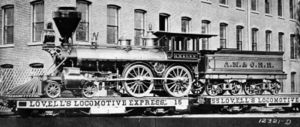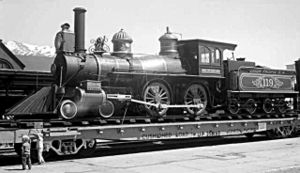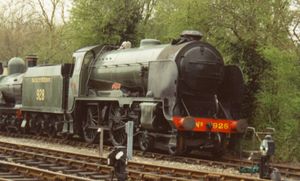4-4-0
2007 Schools Wikipedia Selection. Related subjects: Railway transport

A 4-4-0 is a type of steam locomotive. In the Whyte notation, 4-4-0 signifies that it has a two-axle bogie to help guide it into curves, and two driving axles coupled by a connecting rod. The 4-4-0 is most commonly known as the American type due to the large number of this type that were produced and used there, but the type subsequently became very popular in Great Britain where large numbers were produced. Almost every major railway that operated in North America in the first half of the 19th century owned and operated locomotives of this type. The famous locomotive named The General was a 4-4-0.
The equivalent UIC classification is 2'B.

The first use of the name American to describe locomotives of this wheel arrangement was made by Railroad Gazette in April 1872. Before that time, this wheel arrangement was known as a Standard or Eight-Wheeler. This locomotive type was so successful on US railroads that many earlier 4-2-0 and 2-4-0 locomotives were rebuilt as 4-4-0s by the middle of the 19th century.
American Designs
The first 4-4-0 design was developed by Henry R. Campbell, then the chief engineer for the Philadelphia, Germantown and Norristown Railway. Campbell received a patent for the design in February 1836, and he soon set to work building the first 4-4-0. New locomotive construction in the USA had begun only five years earlier at the West Point Foundry with the Best Friend of Charleston in 1831.
For the time, Campbell's 4-4-0 was a giant among locomotives. Its cylinders measured 14 inch (356 mm) in diameter with a 16 in (406 mm) piston stroke, it boasted 54 in (1.37 m) diameter driving wheels, could maintain 90 lbf/in² (620 kPa) of steam pressure and weighed 12 short tons (11 metric tons). Campbell's locomotive was estimated to be able to pull a 450 short ton (410 metric ton) train at 15 mph (24 km/h) on level track, beating the strongest of Baldwin's 4-2-0s in tractive effort by around 63%.
However, with all of the increased power in Campbell's design, the frame and driving gear of his locomotive proved too rigid for the railroads of the time, thus Campbell's prototype was too prone to derailments. At about the same time as Campbell was building his 4-4-0, the company of Eastwick and Harrison was building its own version of the 4-4-0. This locomotive, named Hercules, was completed in 1837 for the Beaver Meadow Railroad. The Hercules was built with a leading bogie that was separate from the locomotive frame, making it much more suitable to the tight curves and quick grade changes of early railroads.
Even though Hercules and its successors from Eastwick and Harrison proved the viability of the new wheel arrangement, the company remained the sole builders of this type of locomotive for another two years. William Norris built that company's first 4-4-0 in 1839, followed by Rogers, Locks and Canals and Newcastle in 1840. Henry Campbell didn't sit idly by while other manufacturers started building their own 4-4-0s. Like many executives of the modern era, Campbell sued other manufacturers and railroads for infringing on his patent. Baldwin settled with Campbell in 1845 by purchasing a license to build 4-4-0s.
As the 1840s progressed, the design of the 4-4-0 changed little, but the dimensions of a typical example of this type increased. The boiler lengthened, drive wheels grew in diameter and the fire grate increased in area. Early 4-4-0s were short enough that it was most practical to connect the pistons to the rear driving axle, but as the boiler lengthened, the connecting rod was more frequently connected to the front driving axle.

In the following decade, locomotive manufacturers began extending the wheelbase of both the leading bogie and the driving axles. By placing the axles farther from each other, manufacturers were able to mount a wider boiler completely above the wheels that extended beyond the sides of the wheels. This gave newer locomotives increased heating and steam capacity which translated to higher tractive effort. It was in this decade, the 1850s that the 4-4-0 began to look like the locomotives that are preserved today. There are fewer than 40 surviving 4-4-0s in the United States today, not counting reproductions.
The design and subsequent improvements of the 4-4-0 proved so successful that by 1872, 60% of Baldwin's locomotive construction was of this type, and it is estimated that fully 85% of all locomotives in operation in the USA were 4-4-0s. However, the 4-4-0 was soon supplanted by bigger designs, like the 2-6-0 and 2-8-0, even though the 4-4-0 was still favored for express services. The widespread adoption of the 4-6-0 and even larger locomotives helped seal its fate as a product of the past. By 1900, the 4-4-0 was obsolete in US locomotive manufacture, although they continued to serve branch lines and private industry into the mid 20th century. The last 4-4-0 built was a diminutive Baldwin product in 1945, built for the United Railways of Yucatan.
British designs
The 4-4-0 in Britain was primarily favoured for passenger services, although several types were used for mixed traffic services in later years.
The Great Western Railway City class 4-4-0 locomotive City of Truro was designed by George Jackson Churchward and built at the GWR Swindon Works in 1903. It was reputedly the first steam locomotive in Europe to travel in excess of 100 mph (160 km/h), reaching a speed of 102.3 mph (164 km/h) whilst hauling the "Ocean Mails" special from Plymouth to London Paddington on 9 May 1904.
Southern Railway locomotive Stowe is a schools class 4-4-0 locomotive designed by R.E.L. Maunsell. The Schools class was the most powerful 4-4-0 design constructed. All the engines were named after public schools. This engine recorded a speed of 95 mph in 1938, the fastest known time for this class of locomotive, pulling a four coach train. It was built in 1934 at Eastleigh at a cost of £5000. It recorded more than 1 million miles of service operation, and together with its tender, the locomotive weighed 110 tons.
Three examples of this locomotive design are known to survive, Cheltenham owned by the National Railway Museum, Repton owned by the NYMR, and Stowe maintained by the Maunsell Locomotive Society. Stowe was purchased from British Railways for the National Motor Museum when it was assigned to be scrapped in 1962. It was moved to the East Somerset Railway, and then to the Bluebell Railway, where it was put into running order.
See also Southern Railways Schools class Locomotives.
Another famous class of 4-4-0s were the Great Eastern Railway's Claud Hamilton Class, designed by James Holden, versions of which were lated adopted by the LNER.
The type was also used widely on other British railways, particularly in Scotland and East Anglia where tracks that could take lighter weights and more restricted gauges were common.
4-4-0T tank engines
- Highland Railway O Class
Crown Metal Products
The Crown Metal Products Company of Wyano, Pennsylvania built live steam reproductions of classic 4-4-0 designs between 1960 and 1989 for use by amusement parks. The largest of these ran on 36" Narrow Gauge track of which 18 were produced. Most are patterned after 19th century American designs, though those produced for Busch Gardens have European styling. Many of these are still in daily operation at parks such as Paramount's Kings Island , Michael Jackson's Neverland Ranch, and Omaha's Henry Doorly Zoo (see Omaha Zoo Railroad).
In Fiction
Edward the Blue Engine and Molly from Thomas the Tank Engine and Friends are of the 4-4-0 wheel arrangement
| Steam locomotive types |
| Single engine types |
| 0-2-2 | 2-2-0 | 2-2-2 | 2-2-4 | 4-2-0 | 4-2-2 | 4-2-4 | 6-2-0 |
| 0-4-0 | 0-4-2 | 0-4-4 | 2-4-0 | 2-4-2 | 2-4-4 | 4-4-0 | 4-4-2 | 4-4-4 |
| 0-6-0 | 0-6-2 | 0-6-4 | 2-6-0 | 2-6-2 | 2-6-4 | 2-6-6 | 4-6-0 | 4-6-2 | 4-6-4 |
| 0-8-0 | 0-8-2 | 0-8-4 | 2-8-0 | 2-8-2 | 2-8-4 | 2-8-6 | 4-8-0 | 4-8-2 | 4-8-4 | 4-8-6 | 6-8-6 |
| 0-10-0 | 0-10-2 | 2-10-0 | 2-10-2 | 2-10-4 | 4-10-0 | 4-10-2 |
| 0-12-0 | 2-12-0 | 2-12-2 | 2-12-4 | 4-12-2 | 4-14-4 |
| Duplex engine types |
| 4-4-4-4 | 6-4-4-6 | 4-4-6-4 | 4-6-4-4 |
| Garratt (articulated) types |
| 0-4-0+0-4-0 | 2-6-0+0-6-2 | 4-6-2+2-6-4 | 2-8-0+0-8-2 | 4-8-4+4-8-4 |
| Mallet (articulated) types |
| 0-4-4-0 | 0-4-4-2 | 2-4-4-2 |
| 0-6-6-0 | 2-6-6-0 | 2-6-6-2 | 2-6-6-4 | 2-6-6-6 | 2-6-8-0 | 4-6-6-2 | 4-6-6-4 |
| 0-8-8-0 | 2-8-8-0 | 2-8-8-2 | 2-8-8-4 | 4-8-8-2 | 4-8-8-4 |
| 2-10-10-2 | 2-8-8-8-2 | 2-8-8-8-4 |



